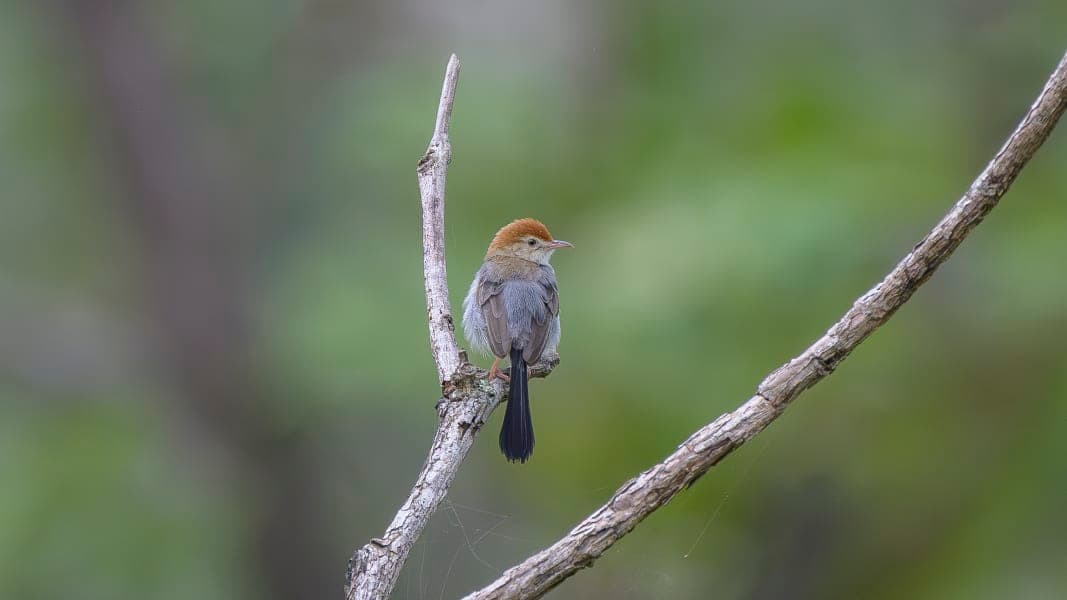John C. Mittermeier / 14 Feb 2025 / Slender-tailed Cisticola
Sometimes the key to finding a lost bird is getting back to the location where it was last seen. This is the case for the Slender-tailed Cisticola which was found and photographed by Michael Mills in northeastern Angola in February 2024, after being lost to science for 14 years. The most recent record before that? August 2010, when the species was photographed by Mills at the same location.
The cisticola, which is called Black-tailed Cisticola by BirdLife International and the IOC World Bird List, is a small gray-brown passerine with an inconspicuous song. True to its name, the bird’s most distinctive physical feature is its tail: glossy-black and slightly longer and narrower than that of similar cisticola species, which are mostly brown-tailed.
The history of the location where the cisticola was rediscovered helps to explain not only its recent rediscovery but also the repeated hiatuses in documenting it. Slender-tailed Cisticolas are endemic to swathes of woodland habitat that stretch over an area the size of Texas in northeastern Angola and the southern Democratic Republic of Congo. Angola experienced more than forty years of war beginning in 1961 with the Portuguese Colonial War (1961-1974) and then the Angolan Civil War (1975-2002), the latter of which claimed the lives of an estimated 500,000 to 800,000 people. Across the border, the Democratic Republic of Congo faced multiple wars during the same period. Provinces on the Angolan border served as access routes for troops and weapons for both countries. The Angolan Civil War ended in 2002, but the recovery from it has been slow and research opportunities for local scientists are limited. As a result, recent ornithological data from the home of Slender-tailed Cisticolas have been sparse.
This was not always the case. The first ornithological studies in Angola were made in the 1800s and the cisticola was described by Western science as long ago as 1882. After the initial description, specimens of the cisticola were collected on 14 occasions prior to 1960. Observations, without accompanying documentation, were made in 1972 and 1988, during lulls in the civil war, and in 2005 and 2009. In 2010 Mills, who has spent years studying the ornithology of Angola and is one of the leading experts on the region’s birds, set out with Martim Melo and Alexandre Vaz to search for the species.
When Mills, Melo, and Vaz began their search in 2010, the Slender-tailed Cisticola was a lost bird. Despite sightings of the species in the 2000s, the last documented record was a specimen collected in 1960. After failing to find the cisticolas at one location, the team moved to an area near the town of Cacolo, where three of the last documented records of the species had come from. The strategy worked. On July 31, 2010, they found a small family group of Slender-tailed Cisticolas and over the course of two days, took the first-ever photographs and sound recordings of the species, providing crucial insights into the cisticola’s behavior and identification.
Mills and his colleagues outlined their 2010 rediscovery in a paper in the Bulletin of the African Bird Club and provided detailed descriptions of the miombo woodland habitat where the birds were found, in addition to the exact coordinates of their sighting. Despite this, no one seems to have visited the location to look for the cisticolas again until Mills decided to return in 2024. The region remains challenging to access and perhaps the fact that the Slender-tailed Cisticola resembles several other cisticola species (considered notoriously difficult-to-identify ‘little brown jobs’ by many African birders) contributed to the lack of follow-up searches.
Hopefully, however, the Slender-tailed Cisticola’s second time lost will be its last. Mills has a birding tour planned for August 2025 which will include looking for the species at the recent rediscovery site. With a bit of luck, there should be more records soon to come.
The cisticola is currently listed as Data Deficient on the IUCN Red List, but hopefully more sightings and information about the species will soon change that. Perhaps someone will also be able document the species in southern Democratic Republic of Congo, where the last documented record was 1960. (There have been recent sightings, however.) Miombo woodland habitats are threatened by clearing for agricultural and firewood in many parts of Africa and so loss of habitat may be the biggest threat to the cisticola’s long-term survival.
If there is a lesson in the cisticola’s story for anyone dreaming of searching for other lost birds, surely it has to do with location. Returning to the site of the most recent documented record can often be the surest path to success.
To learn more about the Slender-tailed Cisticola and its conservation status, check out the species profile in Birds of the World and its Red List page in the BirdLife International Data Zone. With over 900 species, Angola is one of the ornithologically richest countries in Africa; the African Bird Club page is a great starting point to learn more about this incredible avifauna.
